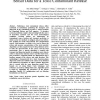Free Online Productivity Tools
i2Speak
i2Symbol
i2OCR
iTex2Img
iWeb2Print
iWeb2Shot
i2Type
iPdf2Split
iPdf2Merge
i2Bopomofo
i2Arabic
i2Style
i2Image
i2PDF
iLatex2Rtf
Sci2ools
JCP
2007
2007
A Genetic Algorithm Method to Assimilate Sensor Data for a Toxic Contaminant Release
— Following a toxic contaminant release, either accidental or intentional, predicting the transport and dispersion of the contaminant becomes a critical problem for Homeland Defense and DoD agencies. To produce accurate predictions requires characterizing both the source of hazardous material and the local meteorological conditions. Decision makers use information on contaminant source location and transport prediction to decide on the best methods to mitigate and prevent effects. The problem has both observational and computational aspects. Field monitors are likely to be used to detect the release and measure concentrations of the toxic material. Algorithms are then required to invert the problem in order to infer the characteristics of the source and the local meteorology. Here, a genetic algorithm is coupled with transport and dispersion models to assimilate sensor data in order to characterize emission sources and the wind vector. The parameters computed include two dimensional ...
| Added | 15 Dec 2010 |
| Updated | 15 Dec 2010 |
| Type | Journal |
| Year | 2007 |
| Where | JCP |
| Authors | Sue Ellen Haupt, George S. Young, Christopher T. Allen |
Comments (0)

